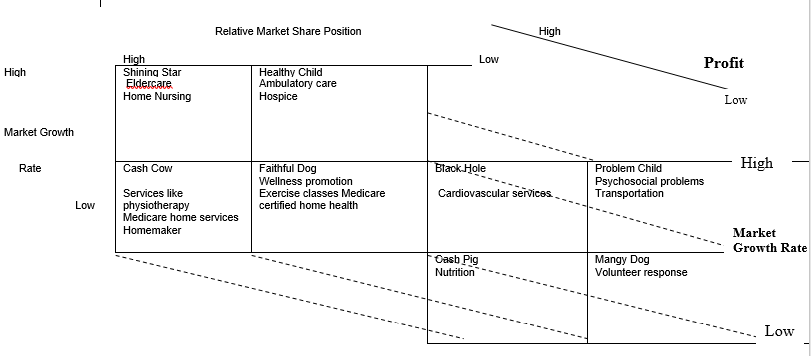Strategy formulation entails the diagnosis of the situational analysis of the internal condition of an organization. This is followed by the formulation of strategies following the identification of the objectives and mission of the organization (Stahl, 2003). The implementation stage is where strategies are actualized, which also involves continuous assessment of the strategies. An example of a status quo strategy in the home healthcare sector is holding the market share within the physiotherapy markets. Examples of related diversification in the home healthcare agency are hospice and Medicare-certified home health (Harris, 2004).
Three alternative strategies in healthcare are directional strategies that are based on mission, vision, values, and goals. The second is adaptive strategies, for instance, corporate-level strategies and divisional strategies. The third type is the market entry strategies that involve acquisition and mergers. Directional strategies make the situational analysis and strategy formulation focus on the broadest strategies that must be founded on the missions of the organization, values, goals, and vision. Expansion of scope deals with the best method to perform the mission and vision like diversification and penetration strategies.
Contraction of scope deals with divestiture and liquidation strategies. Maintenance of scope is the strategy that keeps the organization on an equal playing field like enhancement and status quo strategies (Swayne, Duncan & Ginter, 2008). Cooperation strategies are like mergers, alliances, and joint ventures that allow the healthcare system to maintain a market, while purchase entry strategies allow the organization to use its finances to enter a market. Market entry strategies assist the organization to find resources within and without that will help it enter a home healthcare market while market position strategies are those that help the healthcare service to establish and maintain its products and services within the home healthcare market.

The shining stars- are chosen because they represent products that have high growth, market share, and profits in-home healthcare. Most customers seek services in elderly care and nursing for the critically ill and provide a stable and profitable source of income.
Cash cow- the cash cow is the product that has low market growth but high market share and profitability. In this situation, the home health care agency has a 100% position in the market. We find that services like physiotherapy are often provided by a home care provider.
Healthy children- are those products that have a high profitability market growth and a low share. Often such products offer the organization a chance to grow and hence at a point they can move to the shining star or cash cow sectors. Services like hospice services have the potential to turn into a shining star for the home healthcare agency.
Faithful dogs- these have low market share and growth but are profitable, such products when offered give the organization a less dormant sector that is still profitable.
Black holes- these are products that have market share and growth but have low profitability. This can be seen in instances where costly instruments and technology are used, like cardiovascular services.
Problem children- these are products with high growths, low shares, low profitability which give the organization challenges. These products and services can either shinning stars and cash cows or can be mangy dogs or black holes. Volunteering can be a future cash cow or a mangy dog to the organization depending on how it organizes volunteer work.
Cash pigs- these are products that have high shares, with low growth, and profitability, these in the home healthcare are those that were cash cows, like transportation.
Mangy dogs- these have low growth, share, and profits, and drain an organization, like volunteer response, since they are not obligated, they can offer poor services to the agency.
References
Harris, M.D. (2004). Handbook of Home Health Care Administration. New York: Jones & Bartlett Learning.
Swayne, L., Duncan, W., & Ginter, P. (2008). Strategic management of health care organizations (6th ed.). Hoboken: Wiley & Sons Inc.
Stahl, M.J. (2003). Encyclopedia of Health Care Management. New York: Sage publications.